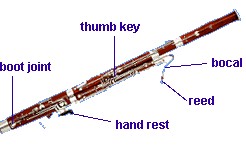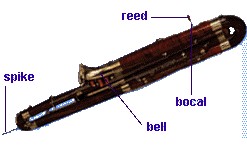How To Choose >Bassoon
How To Choose Bassoon
The bassoon is a double-reed woodwind instrument. It has almost 8 feet of wooden tubing, bent into a narrow U-shape. The reed is secured in a curved metal tube. Bassoons are the largest woodwind instruments in the orchestra - except for the contrabassoon, which is even bigger and plays a whole octave lower than the bassoon!
When playing, Because the bassoon is so long, you had to hold it to one side, next to your knee. You blow into the reed in the same way an oboe player does. The weight of the bassoon is usually supported by a seat strap, which the player hooks on to the lower end of the bassoon and sits on.
Playing the bottom notes of woodwind chords is one of the most important jobs of the bassoon. Bassoons have a rich and mellow sound. One poet compared the bassoon's deep, dark tone to the sound of a sea-god speaking. A contrabassoon is so low in pitch that it seems to "buzz." It can sound very comical! But playing it is no joke. It takes a lot of breath to play a contrabassoon.
History:
The bassoon was most likely developed in 1650 from the curtal, a similar instrument which was made from a single block of wood. The modern French bassoon was developed in the mid-19th century by a French firm, Buffet-Crampon. The German bassoon was perfected by Wilhelm Heckel, a German manufacturer. Each type of bassoon was played in different parts of Europe.
The bassoon's tubular body is divided into four sections, and doubles back on itself to make it easier to play. Playing the bassoon still involves a lot of effort because it's so big and heavy. You'd have to be seven feet tall to play the bassoon if it wasn't folded in half! And you'd have to be standing on a 16-foot-tall ladder to play the contra-bassoon, but then how could you reach the keys?
Because of its low pitch, the bassoon hardly ever plays long solos. But when this does happen, the bassoon can be lots of fun to listen to in choppy passages, which can sound quite comical. The bassoon can also play smooth, long melodies that are very expressive.
Here's a picture of the bassoon, so you can see its major parts.

The bassoon reed is made from a piece of cane which fits on the end of the curved metal tube, which is called a bocal. To make the reed, a strip of cane is cut and shaped, then folded over and tied with twine. The tip is sliced off, leaving an open slit, and the cane at the upper end of the reed is carefully scraped away with a knife until the two blades vibrate freely when you blow.
Like all woodwind instruments, the bassoon has an intricate system of keywork to control pitches. The keys cover holes in the body of the bassoon.
A bassoonist controls no fewer than 13 keys with the thumbs alone! They are called thumb keys. Many of them are linked by rods to pads positioned elsewhere on the instrument.
Two parallel tubes form the boot joint. These are joined at the base by a u-shaped metal tube. This tube is often concealed by a metal end cap.
The bassoon's large hand rest is attached to the boot joint. The rest supports the right hand as it reaches for the keys positioned on the main tube.
Now take a look at the contrabassoon.

It's twice as long as the bassoon, with 16 feet of tubing. It's so long, it's folded over itself four times! Its weight is supported with a spike that sticks out of its lower bend, and it has a bell made of metal.